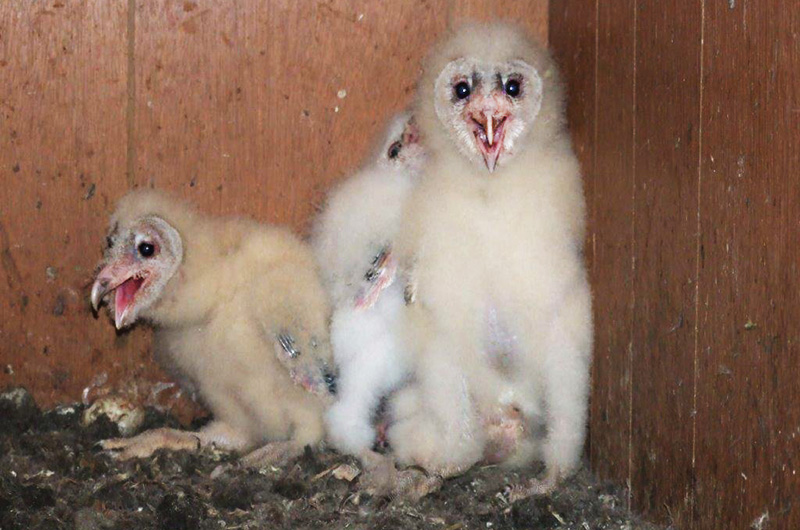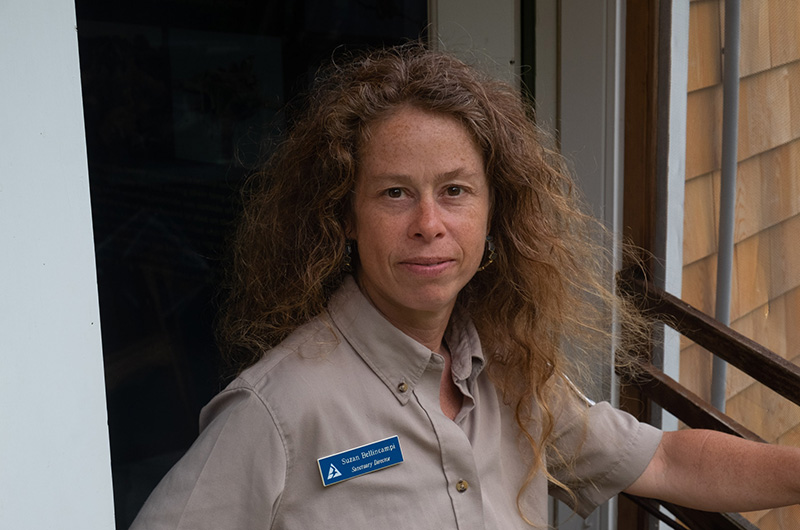Recently, a pair of barn owls and their four owlets moved in above Liz Dengenis’ desk at Felix Neck Wildlife Sanctuary.
“Its funny. Owls are nocturnal, but they’re noisy all day long. They’re loud and rambunctious” said Ms. Dengenis, education coordinator at the sanctuary.
Suzan Bellincampi, director of Felix Neck, agreed.
“Liz listens to them all day and all night,” Ms. Bellincampi said. “And she smells them when they eat small skunks.”
According to Ms. Bellincampi, what makes these barn owls special isn’t their noisy nature, it’s that they’re here at all. Barn owls enjoy southern climates and are typically found in places without much snow cover. Snow gets in the way of hunting for small rodents. But the Vineyard has traditionally been home to some barn owls.
“We are at the northern end of the barn owls’ range and the Vineyard is one of the places where you can reliably see barn owls.” said Ms. Bellincampi.
But in recent years sightings have been scarce.
Ms. Bellincampi said she first began working at Felix Neck in 2006. At the time there was a pair of owls in the owl box, a wooden box in the roof of the office that mimics the rafters of a barn.
“One of the things I thought right away was, we need a camera on these critters,” she said “That’s how we got the barn owl cam up and running. Bearly Read books on the mainland sponsored it. They are really nice folks.”
The camera was outfitted with infrared so people could see the owl family at night. Internet views on the 24-hour owl cam reached 50,000.
But in 2014/15 the Island had record high snowfall and the owls at Felix Neck struggled to find food. This took place in real time on the owl cam and it was hard to watch.
“There were a lot of people from all over the country who were upset,” Ms. Bellincampi said. “They wanted us to feed them and save them.”
But that was not part of the sanctuary’s mission.
“We as an organization help birds but we don’t save every individual animal,” she said. “We protect the habitat and reduce threats. As an organization we made a difficult decision not to intervene. We turned off the camera in 2015, and we waited.”
The owls that winter did not survive and the owl box remained quiet ever since. But this February, Ms. Gengenis and her officemates heard something stirring, and screeching. The camera was turned back on, and while the video technology had not been updated since 2006 it did work. But after the experience in 2014/15, Ms. Bellincampi hesitated at first to share the video of the new owls on the internet.
“Reaching people all over the country was a double edged sword,” she said. “The owl fans are intense. I was getting hate mail.”
In mid-May Ms. Bellincampi noticed the mother owl was sitting on four eggs, and on June 5 the owlets hatched. It was time, she decided, to put the video stream back on the Mass Audubon website.
But the babies will not be here for long. Eight weeks after birth the owlets begin fly, and after 12 weeks they leave the nest for good.
But until then, the staff at Felix Neck Wildlife Sanctuary is enjoying the entire family.
“These are wild animals that casually hang out with us,” said Ms. Dengenis. “How cool!”







Comments
Comment policy »